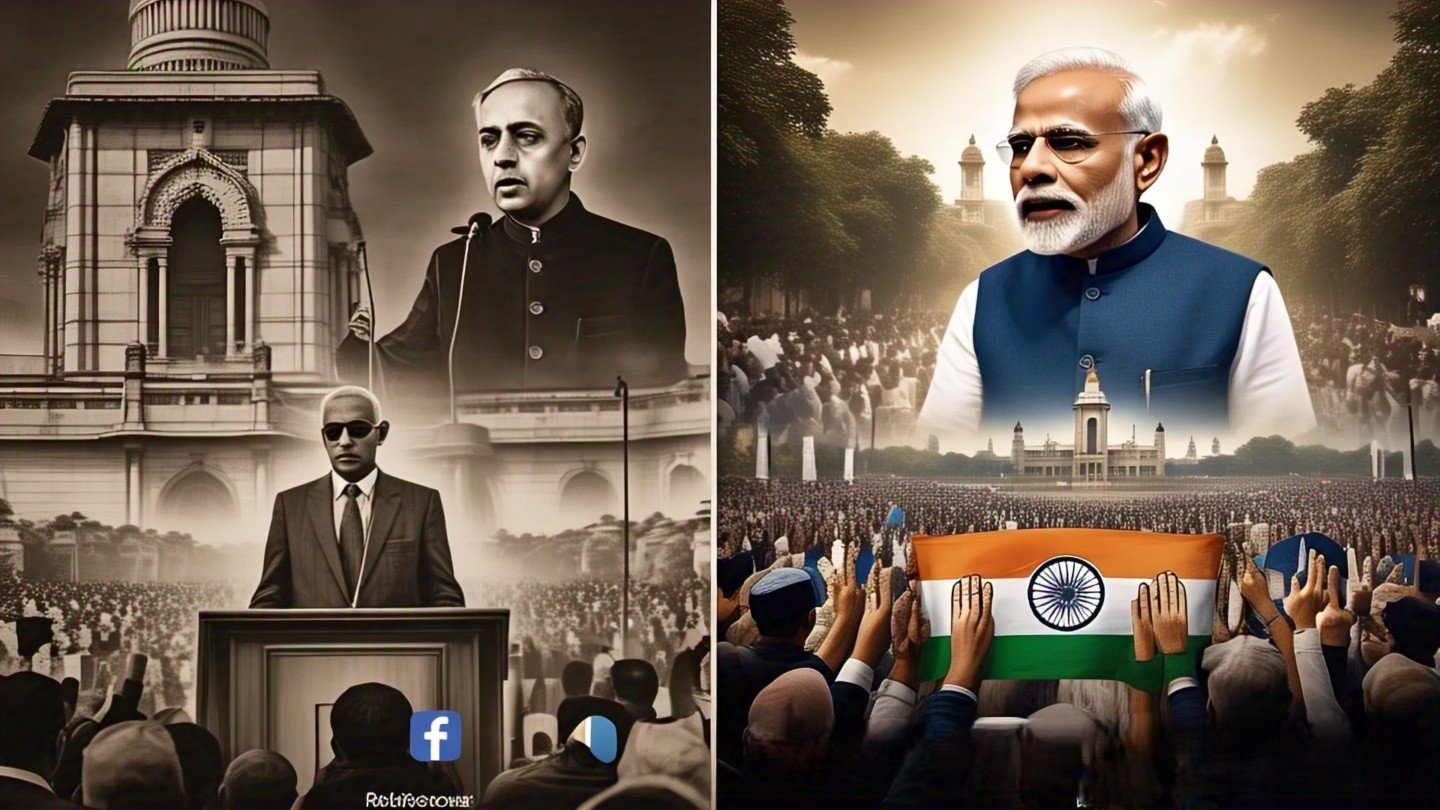From socialism to social media, Indian politics evolution reflects a dynamic shift in power, governance, and public engagement since independence.
Introduction: Indian Politics Evolution – A Journey Through Time
Indian politics evolution has been nothing short of a rollercoaster ride. From the adoption of the Constitution in 1950 to the modern digital battleground of elections, the nation has witnessed a political metamorphosis shaped by leadership, ideology, economic reforms, and emerging technologies. The current political discourse, especially in 2025, is a culmination of seven decades of transformation and turbulence.
At the core of India’s political journey lies the transition from a centralized, single-party dominance to a multi-party coalition framework. The rise and decline of the Indian National Congress, the strengthening of regional powers, the emergence of the Bhartiya Janata Party (BJP), and the impact of globalization and social media have redefined governance, policymaking, and public engagement. This article dives deep into the various phases and forces behind the evolution of Indian democracy, exploring how the past has shaped the present and what the future might hold.
1. Indian Politics Evolution: From Unity to Multipolar Power
The Indian politics evolution reflects a broader shift in democratic engagement, ideology, and public leadership. After independence, India was politically unified under the Congress party. But over the decades, regional demands, social justice movements, and caste-based mobilization gave birth to powerful new voices.
From 1947 to the early 1980s, the Congress party monopolized Indian politics. Post-Emergency, however, coalitions gained strength, enabling the rise of the Janata Dal, BSP, SP, and AIADMK, among others. By the late 1990s and 2000s, national politics became truly multipolar. This multipolarity increased voter choice but also made governments unstable.
Today, in 2025, Indian politics is a vibrant mixture of regional dominance, digital strategies, caste alignments, and youth engagement, as seen in recent legislative shifts like the Waqf Amendment Bill 2025. The shift from a central command to state-centric politics is now the new normal. LSI terms like ‘coalition government in India,’ ‘rise of regional political parties,’ and ‘nationalism in Indian politics’ highlight this trajectory.
2. Indian Political History: A Timeline of Transformation
The Indian political history began with Nehru’s vision of socialism and secularism. As decades passed, India faced key turning points — the Emergency of 1975, the assassination of Indira and Rajiv Gandhi, liberalization in 1991, and the rise of Hindutva politics.
The 1990s saw Mandir-Mandal politics reshape social dynamics. The BJP gained national prominence post the Ram Janmabhoomi movement and Kargil War sentiments. The coalition era (UPA and NDA) redefined political strategies.
Social reforms like the Right to Education, MNREGA, and GST were milestones. The 2014 and 2019 elections signaled a decisive ideological shift led by Narendra Modi’s digital-first approach.
By 2025, Indian political history stands as a reflection of its vibrant struggles and resilience — from ‘Nehru to Modi politics’ to the ‘decline of INC’ and ‘INC vs BJP’ narratives.

3. Evolution of Indian Democracy: From Constitution to Coalition
The evolution of Indian democracy began with the visionary drafting of the Indian Constitution, which laid the foundation for a sovereign, socialist, secular republic. As the years progressed, democratic processes adapted to socio-political demands.
Initially, a centralized system enabled stability. But regional aspirations and social justice led to a federal model with coalition experiments. While democratic institutions survived the Emergency and corruption scandals, voter awareness kept increasing.
The biggest leap came with technology. Digital platforms like Facebook, WhatsApp, and Twitter made democracy accessible and louder. Read how elections continue to shape national discourse in the digital age. Today, AI tools, analytics, and social media microtargeting have transformed how votes are secured and opinions shaped.
The future of Indian politics and the evolution of democracy now depend on balancing data-driven politics with constitutional morality. Keywords like ‘digital campaigning India,’ ‘political marketing India,’ and ‘youth in Indian elections’ capture this shift.
4. Indian Political Parties: Rise, Decline, and Resurgence
India’s multiparty system showcases a diverse ideological spectrum. The Congress party, once unchallenged, has faced steep decline post-2014. The BJP, on the other hand, has emerged as the most dominant force, capitalizing on digital propaganda, nationalism, and welfare schemes.
Regional parties like TMC, DMK, Shiv Sena (UBT), and AAP have leveraged local issues to challenge national hegemony. These parties focus on state identity, regional culture, and hyperlocal welfare delivery.
The rise of political alliances like INDIA vs NDA, with new coalitions forming rapidly, represents the fragmented nature of voter alignment. While ideology matters, electoral success in 2025 hinges more on public outreach, digital messaging, and caste-community arithmetic.
LSIs such as ‘political leadership in India,’ ‘Congress party history,’ and ‘future of Indian politics’ define this new political ecology.
5. Social Media in Indian Politics: The Digital Election Machine
In 2025, social media in Indian politics is more than a campaign tool — it’s a battleground. Political parties deploy AI-driven tools to micro-target users, run influence campaigns, and even deploy deepfakes.
Platforms like WhatsApp, Facebook, and Twitter shape public opinion instantly — even influencing employment narratives as analyzed in our article on AI’s impact on employment in 2025. WhatsApp forwards spread propaganda while memes and reels build party images. Influencers and IT cells operate full-time to control narratives.
AI tools generate auto-personalized responses, chatbot-based manifesto explanations, and voter behavior predictions. This ‘digital election machine’ has redefined outreach — but also raises concerns over misinformation and data misuse.
Frequently Asked Questions (FAQs)
Q1: How has Indian politics evolution influenced modern governance?
Indian politics evolution has deeply influenced governance by making it more decentralized, tech-enabled, and socially responsive. From the Nehruvian era of planned development to Modi’s digital governance, political evolution has spurred new policy paradigms. Governments today rely on real-time data, direct citizen communication, and performance metrics. With AI and social media, policies are now also voter-aligned and sentiment-sensitive, showcasing the impact of political transformation on governance.
Q2: What are the most critical events in Indian political history?
Indian political history is dotted with events that reshaped its course. The adoption of the Constitution (1950), Emergency (1975), liberalization reforms (1991), the Babri Masjid demolition (1992), Kargil War (1999), and the 2014 Modi wave are landmark events. Each represented a turning point in ideology, governance, or national sentiment. These events influenced policy direction, public trust, and electoral outcomes.
Q3: How has the evolution of Indian democracy affected voter behavior?
The evolution of Indian democracy has made voters more empowered, aware, and assertive. With access to social media, data, and digital platforms, today’s electorate evaluates policies, fact-checks claims, and demands transparency. The rise of youth and first-time voters, combined with political literacy and regional activism, has made elections more participatory. Voter priorities now shift from caste and religion to development, employment, and governance quality.
Q4: What role do Indian political parties play in shaping public policy?
Indian political parties shape public policy through their ideological frameworks, manifestos, and electoral mandates. National parties focus on macro issues like defines, economy, and foreign affairs, while regional parties prioritize local infrastructure, jobs, and cultural identity. Coalition dynamics often lead to negotiated policymaking. Policies like GST, Jan Dhan Yojana, and digital initiatives were a result of party ideologies merged with citizen expectations.
Q5: How is social media influencing Indian politics in 2025?
Social media in Indian politics in 2025 is an omnipresent force. It decides narrative dominance, voter outreach, and election outcomes. With AI-generated content, viral memes, live interactions, and issue-based trends, parties connect directly with millions. While it enhances engagement, it also opens the door to fake news, emotional manipulation, and digital surveillance. Regulation and ethical campaigning are now critical in safeguarding democracy.
Conclusion
Indian politics has undergone profound shifts — from Nehru’s vision to Modi’s digital-first governance. The Indian political landscape is no longer confined to ideological divides but influenced by tech innovation, social media, economic policies, and active youth participation. As regional voices grow stronger and AI tools influence election campaigns, the future of Indian democracy looks dynamic, albeit unpredictable.
India’s political evolution tells a story of resilience, reinvention, and relevance in a rapidly changing world. The next phase will be driven by accountability, data-driven outreach, and citizens’ aspirations.

Final Takeaway – Key Insights
- Congress to BJP: Power shift through decades
- 1991 reforms changed political and economic discourse
- Emergency 1975 reshaped civil rights debates
- Rise of coalition politics post-1990
- Digital campaigning redefined elections
- Social media shaped political narratives
- Youth and first-time voters hold major sway
- AI and deepfake tools influence perception
- Regional parties now impact national policymaking
- Future likely to be multipolar and tech-driven
Here are three credible sources that support the information in the article, along with brief explanations of their relevancy:
- The Guardian – Relevance: A highly credible international news organization known for in-depth analysis. Its archives provide substantial coverage of Indian political milestones such as the Emergency, the liberalization era, and the rise of coalition governments. Widely respected global source for historical and political reporting, especially during Emergency, economic reforms, and coalition politics.
- Boell Foundation – Relevance: A reputed policy think tank focusing on democracy and digitalization. Their research papers have extensively analyzed the ethical and societal implications of AI, surveillance, and digital campaigning in Indian elections.
- South Asian Voices –Relevance: A platform powered by regional experts offering scholarly and data-driven insights into South Asian politics. Their work on youth engagement, nationalism, and electoral behavior in India directly aligns with themes discussed in this article.
🌍 Stay informed, stay ahead — follow The Nation Light for stories that shape Nation!
Drop your thoughts in the comments below!
Follow us on social media for more updates:
📢📢 Unlock Your Online Potential with Hostinger!
Struggling with Social Media addiction? To know about The Dark Side of Social Media 👉 Click Here
💻 Turn your screen time into income by creating a money-making website! With Hostinger’s affordable hosting, you can:
- ✅ Build a blog, e-commerce store, or portfolio in minutes
- ✅ Monetize through ads, affiliate marketing, or digital products
- ✅ Enjoy lightning-fast speed & 99.9% uptime
🎁 Exclusive 20% OFF for our readers:
👉 Hostinger Affiliate Link
Why Hostinger?
- ✔ 1-click WordPress install (perfect for beginners!)
- ✔ 24/7 live chat support
- ✔ Free SSL certificate (secure your site)
🌟 Example Success:
Riya, a former Social Media addict, now earns $750 /month from her self-care blog—built on Hostinger in just 2 days!
Your Turn:
- 1️⃣ Sign up with our link
- 2️⃣ Launch your site (use detox tips as content!)
- 3️⃣ Start earning while helping others break free!
💡 “Your phone is a goldmine—stop scrolling, start selling!”
Affiliate Disclosure: This page contains affiliate links. We may earn a commission at no extra cost to you.
You May Like Below
Cinema Advertising Trends 2025: 7 Shocking Truths Behind PVR INOX
Cinema advertising trends 2025 reveal how PVR INOX fueled Aamir Khan’s Sitaare Zameen Par success. Urban films are making a…
US Attacks Iran Nuclear Sites: 3 B2 Bombers Obliterate Fordow
US attacks Iran nuclear sites as B2 bombers hit Fordow. Get the latest on US Iran war news, Israel conflict…
Google Passwords Leaked 2025: 16 Billion Credentials Exposed in Massive
Google passwords leaked 2025: A shocking 16 billion credentials were exposed in the latest data breach threatening Apple, Facebook, and…
Is the Stock Market Open on Juneteenth? 5 Shocking Closures
Is the stock market open on Juneteenth 2025? Discover surprising closures of banks, USPS, Costco, and more. Check what’s open…
Israel Iran War Latest News Today: 7 Shocking Facts After
Israel Iran war latest news today: Iran fires missiles, Khamenei issues stern warning, Trump responds — chaos deepens in Middle…
AI Job Loss Prediction 2025: Geoffrey Hinton Reveals 7 Careers
AI Job Loss Prediction 2025: Geoffrey Hinton warns of mass joblessness—discover what AI can’t replace and which careers are truly…







